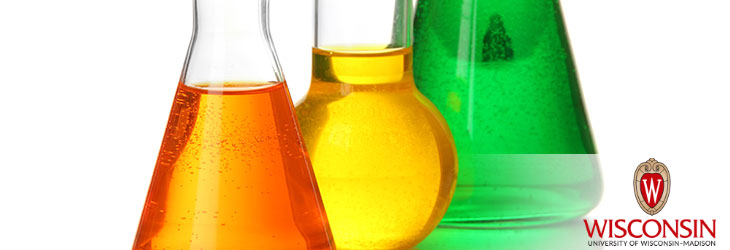Materials & Chemicals

Synthesis of Proteins and Peptides Selectively Modified by Sulfation, Phosphorylation or Glycosylation
WARF: P02386US
Inventors: Laura Kiessling, Travis Young
The Wisconsin Alumni Research Foundation (WARF) is seeking commercial partners interested in developing methods and protected amino acid building blocks for the synthesis of selectively modified proteins and peptides.
Overview
The lack of methods to easily synthesize sufficient quantities of selectively modified peptides and proteins has hindered research on the biological functions and molecular interactions of side-chain modified peptides and proteins, particularly those peptides and proteins in which the side-chains of hydroxylated amino acids are modified to carry a sulfate group, a phosphate group or saccharides. While techniques for the synthesis of modified peptides and proteins are available, more efficient, higher yield and less complex synthetic methods are needed. Improved methods for the selective modification of a subset of similar or analogous sites in a peptide or protein also are needed.
The Invention
UW–Madison researchers have developed methods that use a new protecting group strategy for the synthesis of proteins and peptides that are selectively modified by sulfation, phosphorylation and/or glycosylation. The methods use hydroxyl protecting groups with an azide moiety, which do not react under the conditions typically used in peptide synthesis, to create protected amino acids useful as building blocks for the synthesis of proteins or peptides. After synthesis, the amino acid residues can be selectively deprotected and modified.
Applications
- Synthesis of peptides and proteins that are selectively modified at one or more side-chain hydroxyl groups, e.g., by sulfation, phosphorylation or glycosylation
- Synthesis of combinatorial libraries of peptides
Key Benefits
- Capable of selectively modifying one or more side-chain hydroxyl groups
- Can be used to select the pattern (spacing, number and/or type) of modifications along the peptide chain
- Particularly applicable to tyrosine, serine and threonine residues
- Azide-bearing protecting groups generally are stable under acidic and basic conditions, providing additional synthetic flexibility for peptide and protein synthesis.
Publications
- Young T. and Kiessling L.L. 2002. A Strategy for the Synthesis of Sulfated Peptides. Angew Chem. Int. Ed. Engl. 41, 3449-3451.
Tech Fields
For current licensing status, please contact Rafael Diaz at [javascript protected email address] or 608-960-9847